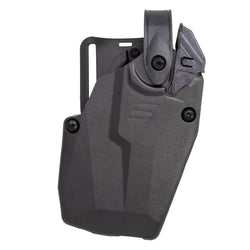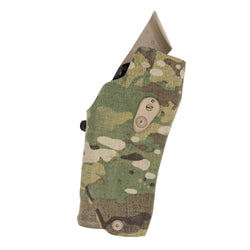The Beretta M9, a military version of the Beretta 92FS, has armed U.S. service members from 1985 to the present day. While it’s now being phased out in favor of the SIG Sauer M17/M18 series, the M9 will likely remain in service for several more years as replacements are gradually issued.
The Beretta M9 has always been a controversial weapon. Some of that stems from performance issues, but much of it traces back to the fact that it replaced the beloved M1911 and .45 ACP.
If such a thing existed, the Beretta M9 would deserve a spot in the Handgun Hall of Fame. The M1911 served from 1911 to 1985, which is impressive. In those 74 years, the gun participated in WW1, WW2, Korea, and Vietnam.

If we calculate its time in combat, it totals approximately 16.5 years. In the Global War on Terror alone, the M9 served for 19 years, 11 months, 2 weeks, and 2 days. It’s a legendary firearm.
The last M9 rolled off the assembly line on August 8th, 2021, but today, we’re celebrating the history, performance, and lasting legacy of the Beretta M9.
History of the M9
Beretta has been around since the 1500s. The origin of the Beretta M9 can be traced to 1918, when Beretta released the Model 418. This handgun featured some early design elements that would dominate Beretta’s handgun design, namely the exposed barrel.
Beretta maintained this design as it produced more handguns. The Beretta M1951 delivered a 9mm handgun, from which the M9 or 92 series can easily trace its lineage.

Evolution of the 92 Series
The first Beretta 92 appeared in 1975. Its design used an exposed slide, an alloy frame, and a hinged locking block like the Walther P38. In the mid-1970s, the world was moving toward 9mm handguns with an initial double-action trigger pull followed by a subsequent single-action trigger.
Additionally, double-stack magazines were becoming the standard, and all of these features were incorporated into the Beretta 92 series.
The 92 series continued to evolve with various feature updates and ergonomic improvements. In 1980, the Beretta 92SB-1 became the first version of the 92 series tested by the US Military.
Becoming the M9
The adoption of the M9 and replacement of the M1911 is a long and complicated story. It all started when a few politicians challenged the DoD’s way of doing things. After finding out the military had several different handguns in service, they demanded standardization.
In response, the Joint Service Small Arms Program (JSSAP) was created. This group, made up of members from each branch of service, came together to develop the requirements for new weapons and establish the testing procedures necessary for adoption.

The Search for a Standard Firearm
JSSAP’s first project was finding a replacement for the M1911, along with the various other handguns still in service among the general military population. For the program, they developed a total of 85 requirements. The core criteria came down to this:
- Chambered in 9mm for NATO standardization
- Detachable magazine with a capacity of at least 13 rounds
- The magazine falls free when the release is pressed
- DA/SA Action
- Slide-stop locks open when the magazine is empty
- Durability of 5000 rounds with no more than eight malfunctions.
There was a lot of internal resistance to switching to 9mm and replacing the M1911, which resulted in different trials. The first trials ended in 1980, with the Beretta 92SB-1 being the winner and the future M9. These initial trials were conducted by the Air Force.
The Army protested the trials, largely because the M1911s used were issued guns—not factory-new samples.

XM9 Trials and Final Selection
The Army insisted on taking over the program and was granted that request. In 1981, they issued their own requirements and received samples. However, they terminated the program in 1982, claiming none of the submitted samples met their requirements. The Army claimed reliability issues but released little information regarding the tests.
After a storm of criticism and media coverage, a third round of tests—the XM9 trials—was conducted in 1983 and 1984. Beretta entered the 92SB-F, later shortened to the 92F. In the end, SIG Sauer and Beretta more or less tied.

Beretta came forward with a lower purchase price and won the contract. The Beretta 92F became the M9.
The M9 gave soldiers a DA/SA, semi-automatic, short-recoil-operated 9mm pistol fed by a double-stack magazine. It was a hammer-fired gun with an ambidextrous slide-mounted safety that doubled as a decocker. The sights were fixed, and a lanyard loop kept the gun where it was supposed to be.
Problems With the M9
There were some growing pains with the M9 series of pistols. Namely, there were problems with the slide breaking off the back and injuring shooters. This became an issue with M9s with high round counts.
It became a joke that you weren’t a real Navy SEAL until your face had “eaten” a Beretta slide.
The military blamed Beretta, while Beretta blamed the Army for using ammo that exceeded NATO specifications. The fix came in the form of an enlarged hammer pin, and these updated models became classified as the Beretta 92FS.

A second problem occurred during the early days of the Iraq War. M9s were having reliability problems, which were traced to the magazines. The United States military did not contract with Beretta for magazines but went with an outside provider.
It was later discovered that the heavy phosphate coating on the magazines poorly interacted with the sand in Iraq.
God and Country
The M9 seemed to be embroiled in controversy during its lifespan, especially during the peacetime era and the early days of the GWOT. As the war progressed, the problems disappeared. It’s also worth noting that handguns are used in warfare a hair more than bayonets.
With that in mind, the M9 became an iconic symbol of the Global War on Terrorism. On November 13th, 2004, a photo of then-First Sergeant Bradley Kasal showed him severely wounded in the legs, being carried by two fellow Marines—M9 and Ka-Bar in hand.

The photo symbolized the fighting spirit of the American Marine. Even while wounded and being evacuated, this Marine carried a weapon and was ready to fight. This iconic image was replicated as a statue at Wounded Warrior Battalion West, named “No Man Left Behind.”
My M9
I carried an M9 for a few years as a machine gunner. My old M9 wore a proud patina from its miles of service. It rattled like a baby’s toy, and the lack of a finish gave it a near-stainless steel look.
I never employed the weapon tactically, but it never failed in training or at annual qualification. I admittedly loved the gun—it’s the weapon that sparked a lifelong appreciation for DA/SA hammer-fired pistols.

I always found it to be an accurate, lightweight, and low-recoiling gunn. I enjoyed the rolling double-action trigger and the light single-action. The safety/decocker was annoying, but it was something I could deal with.
The military adopted limited numbers of the M9A1, which featured a Picatinny rail for accessories. I never saw one fielded and wasn’t sure if they ever made it to the infantry or to the Marine Corps as a whole.
The End of the M9
After a lengthy series of trials, the M17 and M18 from SIG Sauer were chosen as the replacement for the M9. As mentioned, the last M9 rolled off the assembly line in 2021. The M9 series has served admirably and armed our servicemembers with a robust and capable handgun.
While the military is moving on from the M9, Beretta has not.
The company has introduced both A3 and A4 models—modernized takes on the classic M9. These versions feature accessory rails, with the A4 offering optics compatibility. Slimmer grips and increased magazine capacity round out the updates, making them highly capable handguns for both defense and duty use.

If an M9, Beretta 92FS, or any of the many M9 variants occupies your hands, it should also ride in a Safariland holster. Safariland sets the standard for retention and continues to produce the best duty holsters in the world.











